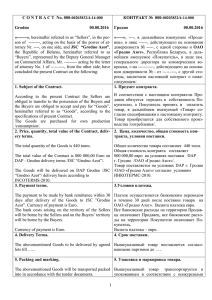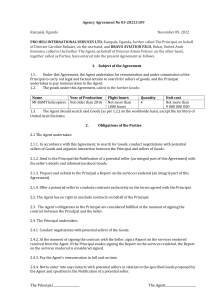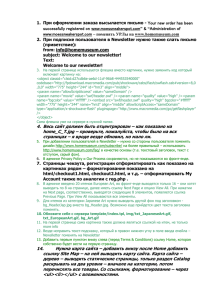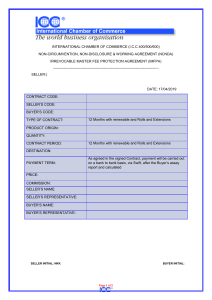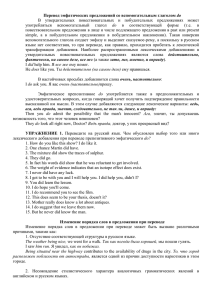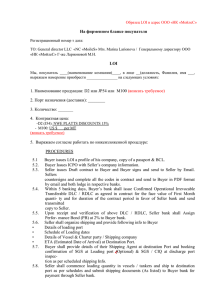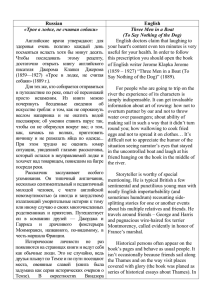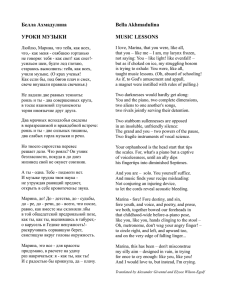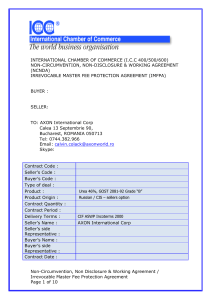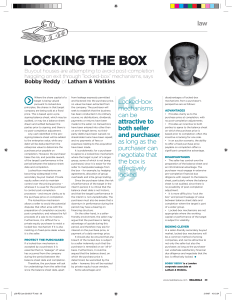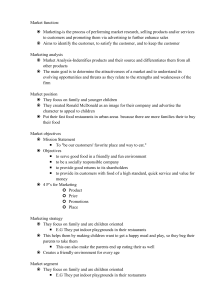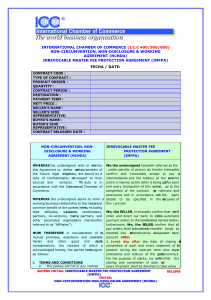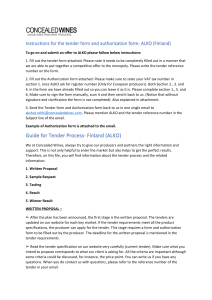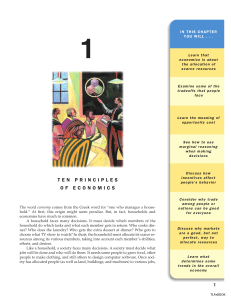1. Translate the following text: COMPETITION IN A FREE MARKET
advertisement
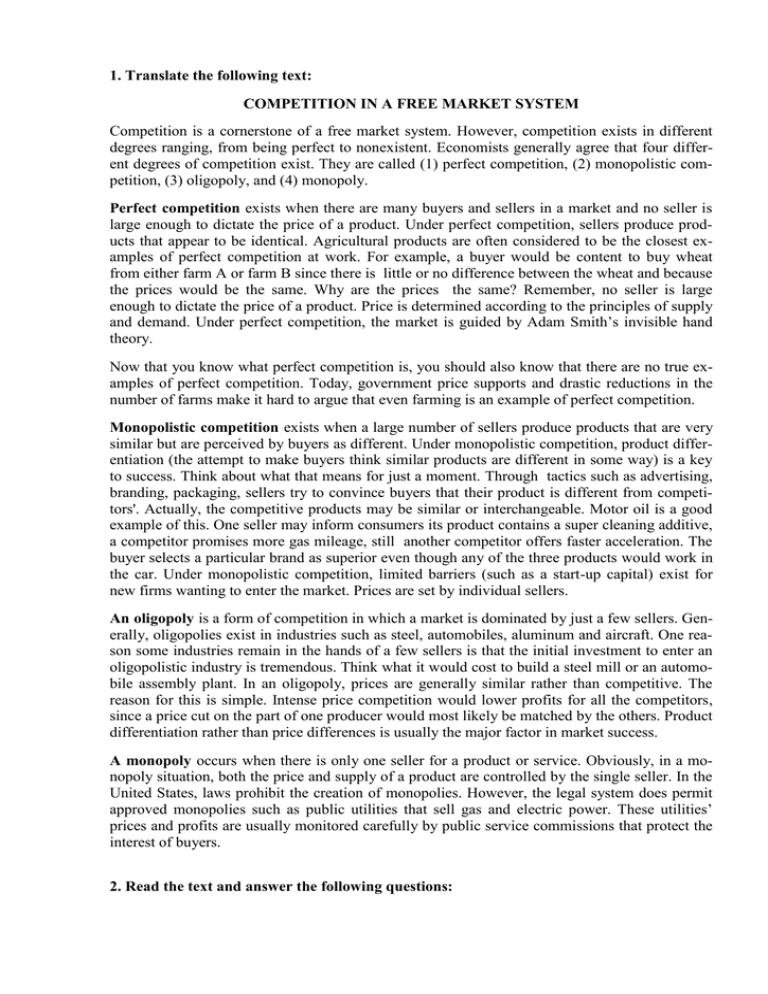
1. Translate the following text: COMPETITION IN A FREE MARKET SYSTEM Competition is a cornerstone of a free market system. However, competition exists in different degrees ranging, from being perfect to nonexistent. Economists generally agree that four different degrees of competition exist. They are called (1) perfect competition, (2) monopolistic competition, (3) oligopoly, and (4) monopoly. Perfect competition exists when there are many buyers and sellers in a market and no seller is large enough to dictate the price of a product. Under perfect competition, sellers produce products that appear to be identical. Agricultural products are often considered to be the closest examples of perfect competition at work. For example, a buyer would be content to buy wheat from either farm A or farm B since there is little or no difference between the wheat and because the prices would be the same. Why are the prices the same? Remember, no seller is large enough to dictate the price of a product. Price is determined according to the principles of supply and demand. Under perfect competition, the market is guided by Adam Smith’s invisible hand theory. Now that you know what perfect competition is, you should also know that there are no true examples of perfect competition. Today, government price supports and drastic reductions in the number of farms make it hard to argue that even farming is an example of perfect competition. Monopolistic competition exists when a large number of sellers produce products that are very similar but are perceived by buyers as different. Under monopolistic competition, product differentiation (the attempt to make buyers think similar products are different in some way) is a key to success. Think about what that means for just a moment. Through tactics such as advertising, branding, packaging, sellers try to convince buyers that their product is different from competitors'. Actually, the competitive products may be similar or interchangeable. Motor oil is a good example of this. One seller may inform consumers its product contains a super cleaning additive, a competitor promises more gas mileage, still another competitor offers faster acceleration. The buyer selects a particular brand as superior even though any of the three products would work in the car. Under monopolistic competition, limited barriers (such as a start-up capital) exist for new firms wanting to enter the market. Prices are set by individual sellers. An oligopoly is a form of competition in which a market is dominated by just a few sellers. Generally, oligopolies exist in industries such as steel, automobiles, aluminum and aircraft. One reason some industries remain in the hands of a few sellers is that the initial investment to enter an oligopolistic industry is tremendous. Think what it would cost to build a steel mill or an automobile assembly plant. In an oligopoly, prices are generally similar rather than competitive. The reason for this is simple. Intense price competition would lower profits for all the competitors, since a price cut on the part of one producer would most likely be matched by the others. Product differentiation rather than price differences is usually the major factor in market success. A monopoly occurs when there is only one seller for a product or service. Obviously, in a monopoly situation, both the price and supply of a product are controlled by the single seller. In the United States, laws prohibit the creation of monopolies. However, the legal system does permit approved monopolies such as public utilities that sell gas and electric power. These utilities’ prices and profits are usually monitored carefully by public service commissions that protect the interest of buyers. 2. Read the text and answer the following questions: 1. What factors determine the price of a product under different forms of competition? 2. What is the difference between perfect and monopolistic competition? 3. What is the reason for the existence of oligopolies? 4. Why are prices in an oligopoly not competitive? 5. When does the monopoly occur? 3. Find in the text the English equivalents of the following expressions: Система свободной торговли, конкуренция среди продавцов, иметь открытый доступ к рынку, при совершенной конкуренции, в соответствии с принципами предложения и спроса, резкое сокращение количества ферм, воспринимаются покупателями как разные, реклама, снабжение товара торговой маркой, конкурентоспособная продукция, начальные капиталовложения, понижать доходы, снижение цены. 4. Find in the text the words that correspond to the following definitions: 1. a person or business organization competing with one another or others 2. market in which there is only one seller 3. market dominated by a few firms 4. to have the most important place or position 5. unlike, not of the same kind 6. a person or company that produces goods 5. Complete the sentences below with derivatives of the words used in the text. Verb To compete ? To divide ? To advertise Noun ? investment ? ? difference ? Adjective ? monopolistic ? 1. The new product developed by the company is … in the domestic market. 2. Under … competition prices are determined by individual sellers. 3. … helps sellers to convince buyers that their product is … from others. 4. The … of labor enables producers to increase the output of products. 5. Foreign companies … large sums of money into new enterprises on the territory of Russia. 6. Are the following statements true or false. If they are false correct them. 1. Competition exists in two degrees: perfect and monopolistic. 2. Agricultural products are true examples of perfect competition. 3. Under monopolistic competition sellers of similar products try to convince buyers that their product is different from competitors’. 4. In oligopoly prices are competitive and this is the main factor in market success. 5. A monopoly occurs when there is only one seller of a product or service. 7. Translate the following sentences into English: 1. При совершенной конкуренции продавцы производят одинаковые товары, и ни один продавец не может устанавливать цену на товар. 2. Цена определяется в соответствии с принципами предложения и спроса, т.к. при совершенной конкуренции рынком управляет теория “невидимой руки” А. Смита. 3. Когда большое количество продавцов производят сходные товары, они пытаются заставить покупателей думать, что эти товары как-то отличаются друг от друга. 4. Продавцы используют рекламу, торговые марки, упаковку, чтобы сделать товары конкурентоспособными. 5. Такие отрасли промышленности, как сталелитейная, автомобилестроение, самолетостроение и другие остаются в руках нескольких продавцов, т.к. необходимы огромные капиталовложения, чтобы построить такие предприятия. 6. Когда есть только один продавец товара или услуги, как цена, так и предложение контролируются этим продавцом.

